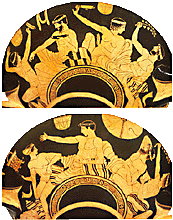

|
The Classical Athenian symposion was a social event for men only: it could be a private or a public affair. The occasion for a symposion might be a family festival, a city festival, victory in an athletics or a poetry competition, or the arrival or departure of a friend. Men of aristocratic rank in particular would meet very often to dine together. A symposion was divided into two parts: first the banquet, and then the symposion proper. During the first half wine was drunk - in moderate quantities - and during the second, which lasted longer, the 'symposiasts' continued drinking wine, accompanying it with tragemata. |
 |
|
The wine was usually diluted with water (one part wine to two or three parts water). They were mixed in a krater. Wine without water ('unmixed' wine) was only drunk for a toast or some very special reason. Drink was served in clay (or metal) bowls by slaves, who would be young men or women. The members of the symposion kept each other entertained with discussions, poetry readings, riddles and conundrums, music and dancing and virtuoso displays - see Xenophon's Symposion (2,1-2) - as well as pastimes such as the kottabos game. Normally an Athenian woman would not attend a symposion. The only occasion on which she might do so would be in the second half - if she were a musician playing the aulos, a dancer, or a hetaira. She would do so in order to keep the menfolk company and entertain them. The symposion also served to educate ephebes (18-20-year-olds) of the aristocratic class, giving them the chance to listen to the symposiasts' conversation, and learn the mysteries of the value system of their class. |
|
The area in the house where a symposion were held was the andron or, if it was being organized by the city, some public building. As the symposiasts ate and drank they would normally be reclining on their anaklintron, two (or more rarely three) on each. They rested on one elbow, with the body upright or at a slight angle, very often with the support of a cushion or large headrest. The place of honour was next to the master of the house, who might instruct each of his guests where to sit. There were small movable tables, one for each symposiast (or alternatively one in front of each anaklintron). There was restricted space for the symposion, as there might be anything from seven to twelve anaklintra in the room, usually parallel with the walls or placed in such a way that all of them were on the same level and every member of the symposion could see every other member. This made for spontaneous communication and discussion, which was what mattered at such gatherings. It should be added that even when the symposion was a public one, the room would be quite a small one. |
Once they arrived at the house where the symposion was to take place, the guests would remove their shoes. The slaves would then wash their feet and show them to the symposion room. A symposiast often wore a crown of leaves or flowers on his head and a floral necklet called the hypothymis. When all the guests had taken their places, the slaves would bring an oinochoe and a lekane for them to wash their hands. The banquet would begin with the propoma (or 'loving-cup'), a glass of spiced wine that all the symposiasts sipped from before the meal. |
Some of the guests would arrive after the banquet, and would attend only the second part of the symposion. This began with libations to the gods, and in particular to Dionysos, the wine god. The libation was performed by drinking a little unmixed wine and tipping a few drops of it onto the ground and uttering the god's name. This was followed by a hymn. Lots were then drawn to decide who should be 'president' of the symposion (symposiarchos), his duties being to rule on what the proportion of wine to water in the mixing-bowl should be and how many glasses each symposiast had to empty. Anyone not obeying the president's ruling would be subject to a forfeit.
 |
 |
|
| |
|||
| |||